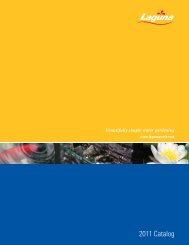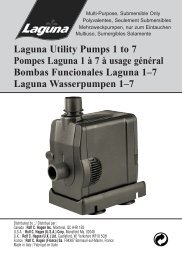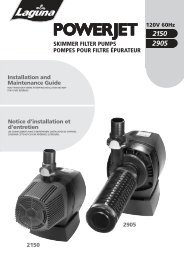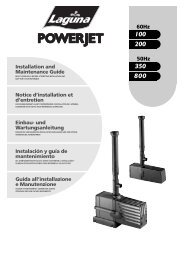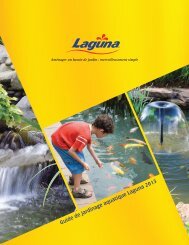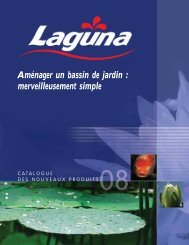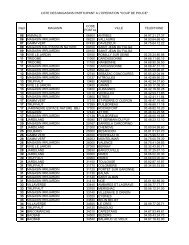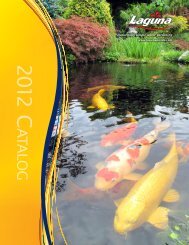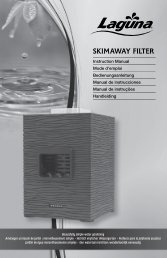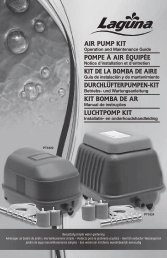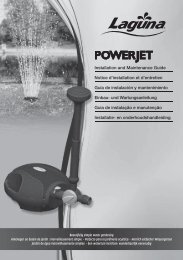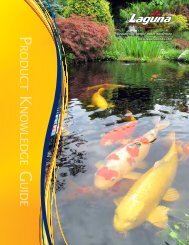Laguna - 2013 Guide to Water Gardening - Lagunaponds.com
Laguna - 2013 Guide to Water Gardening - Lagunaponds.com
Laguna - 2013 Guide to Water Gardening - Lagunaponds.com
You also want an ePaper? Increase the reach of your titles
YUMPU automatically turns print PDFs into web optimized ePapers that Google loves.
Spring Opening<br />
Clean up<br />
The first thing you will need <strong>to</strong> do is clean up the mess left over during the course of the<br />
previous fall and winter. Use a pond net, skimmer or pruning <strong>to</strong>ol <strong>to</strong> remove leaves,<br />
twigs and debris in, around, and at the bot<strong>to</strong>m of the pond. Use your pond vacuum <strong>to</strong><br />
suck up dirt and plant matter from the base of the pond. Make sure your thermometer is<br />
working properly, if it isn’t, install a new one.<br />
Refilling<br />
Early spring is a good time <strong>to</strong> do a water change of up <strong>to</strong> 50%-75%, depending on the<br />
pond’s condition (and what was done in the fall). Winter run-off may contain pollutants<br />
that may have seeped in<strong>to</strong> the pond, use a pump <strong>to</strong> partially drain the pond. Before<br />
refilling the pond, let the water run a few minutes <strong>to</strong> flush the pipes. After replenishing<br />
the water, add <strong>Laguna</strong> <strong>Water</strong> Prep <strong>to</strong> eliminate chlorine and chloramine as well as <strong>to</strong><br />
neutralize harmful metals.<br />
Starting the equipment<br />
Pond equipment should have been cleaned and packed away for winter; if it wasn’t,<br />
make sure that you clean them thoroughly before restarting. Take your filter apart and<br />
thoroughly rinse all media in a bucket of water (use pond water taken from the pond<br />
- never use tap water as the chlorine will kill off the beneficial bacteria that keep your<br />
pond water in biological balance). Replace filter foams if required before reinstalling your<br />
filtration systems. If pumps were in operation over the winter, remove and clean them.<br />
Reassemble any hoses and other water runs and inspect for damage. Repair and replace<br />
as required, then test <strong>to</strong> ensure that everything works. If you have a waterfall,<br />
use waterfall foam <strong>to</strong> fill in gaps and openings in waterfall area. If you have a<br />
UV sterilizer or if your filter contains a UV-C lamp, early spring is a good time <strong>to</strong><br />
replace the bulb as its effectiveness dramatically reduces after 12 months. When the<br />
water temperature remains above 7ºC / 45ºF, start the filter and the UV sterilizer <strong>to</strong><br />
maintain clear water. To help achieve optimum water conditions, add in barley straw<br />
and peat granules <strong>to</strong> the filter’s biochamber or directly in<strong>to</strong> the pond (using a mesh<br />
bag <strong>to</strong> contain the product).<br />
Adding fish<br />
Fish that have been kept indoors for the winter will need time <strong>to</strong> adjust <strong>to</strong> the pond’s<br />
environment. A sudden change in temperature and pH level can harm them. Ensure that<br />
the water temperature is a minimum 15°C /60°F before relocating the fish back in<strong>to</strong> the<br />
pond. Allow them <strong>to</strong> acclimatize gradually. Never pour or drop them in<strong>to</strong> the pond. Gently<br />
net and place them in a plastic bag for transportation.<br />
If you have purchased new fish, put the bag in the pond and let it float untied on the<br />
water surface. Wait about 10 minutes or until the temperature of the bag and the water<br />
are about equal, then untie the bag and add a small amount of pond water <strong>to</strong> the bag<br />
and leave for another 10 minutes. Repeat the process once or twice more, then add ½ a<br />
cap of <strong>Water</strong> Prep pond water neutralizer before gently allowing the fish <strong>to</strong> swim out of<br />
the bag and in<strong>to</strong> the pond. Moving can be traumatic for fish, so watch them carefully <strong>to</strong><br />
ensure that they’re adjusting <strong>to</strong> their new surroundings and that there are no losses. Also<br />
check ammonia and nitrite readings regularly, using a pond test kit, <strong>to</strong> ensure that the<br />
biological filter is establishing rapidly and effectively.<br />
Fish should be fed only when the water temperature is consistently above 8°C/46.4º F.<br />
Once above 8°C/46.4ºF, begin feeding a spring/fall formula food enriched with wheat<br />
germ, it is low in protein, easier <strong>to</strong> digest, and helps minimize waste. When the water<br />
temperature stays above 10ºC/50º F, switch <strong>to</strong> an all season formula. Feed amounts<br />
that fish can eat within a few minutes and remove any uneaten food.<br />
48 ••• Spring opening




